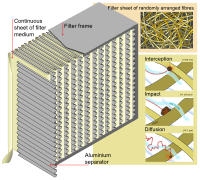
Photo from wikipedia
Abstract Commercial almond pasteurization often involves thermal treatments to control Salmonella , and evaluation of non-thermal technologies such as irradiation, is warranted. Direct and indirect effects of irradiation affect pathogens… Click to show full abstract
Abstract Commercial almond pasteurization often involves thermal treatments to control Salmonella , and evaluation of non-thermal technologies such as irradiation, is warranted. Direct and indirect effects of irradiation affect pathogens by causing cellular DNA breakdown and further damage via free radicals by hydrolysis of water molecules. The presence of oxygen may participate in the secondary effects, promoting the generation of radicals that intensify the antimicrobial effect of irradiation. In this study, the sensitivity of Salmonella on almonds to electron beam (e-beam) irradiation under air and vacuum packaging was investigated. Almonds inoculated with S . Typhimurium LT2 were air- or vacuum-packaged, and then subjected to e-beam irradiation at different doses. The D 10 value (radiation dose needed to reduce 90% of the Salmonella population) on vacuum-packaged almonds (0.46 kGy) was significantly greater (P 10 value or air-packaged almonds (0.30 kGy). Results indicated that the presence of oxygen possibly enhanced the reduction of Salmonella on the almond surface, compared to vacuum-packaged almonds when subjected to the same irradiation dose. These results suggest that combining e-beam irradiation with air packaging to permit the presence of oxygen in the package during treatment may be a feasible non-thermal intervention to reduce Salmonella on almonds.
Journal Title: Lwt - Food Science and Technology
Year Published: 2019
Link to full text (if available)
Share on Social Media: Sign Up to like & get
recommendations!